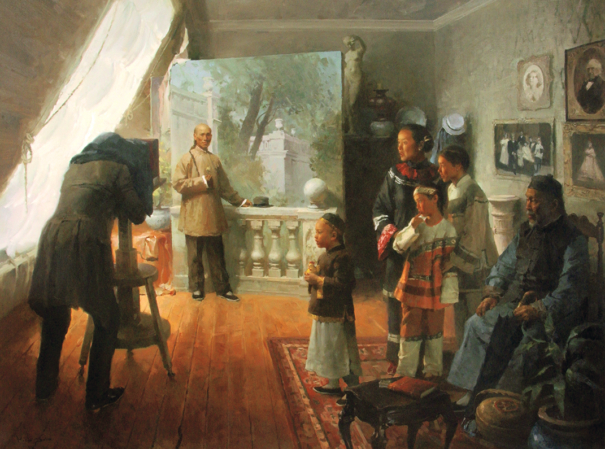
Exhibitions
Finding Home: The Chinese American West is curated by Lele Barnett.
This exhibition is organized by Tacoma Art Museum as part of the [re]Frame: Haub Family Collection of Western American Art project.
During the 1850s, Chinese laborers sought refuge in the United States from political instability and economic upheaval in China. Many came from Guangdong Province, which had experienced extreme floods and famine. These immigrants played pivotal roles during the California Gold Rush in the 1850s, contributed significantly to the construction of the Central Pacific Railroad in the 1860s, and served as laborers in western mines. Many grew successful and became entrepreneurs in the United States.
Born a century later in Guangdong Province, artist Mian Situ initially believed the tales of “Gold Mountain” prosperity in the American West. His research later revealed the pioneers’ harsh realities—exploitation, abuse, and racism. This inspired him to capture their experiences in his work, depicting not only their triumphs but also their trials and tribulations.
Despite their noteworthy contributions to shaping the American West, historical images rarely depict Chinese immigrants. Though it has an extensive range, the Haub Family Collection of Western American Art does not include any historic works created by or depicting Chinese Americans. These two works by Mian Situ—Beef, Beans and Biscuits and The Entrepreneur—are contemporary additions to the collection that bridge this gap.
On November 3, 1885, a mob of several hundred white residents, spearheaded by a group that included the mayor, violently assaulted and expelled Tacoma’s Chinese population. They burned Chinese-owned homes and businesses, then forcefully removed residents, banishing them from the city. This tragic occurrence was part of a larger pattern of anti-Chinese sentiment and discrimination prevalent in the United States at that time.
It highlighted deep-rooted racism, xenophobia, and economic anxieties and resulted in the displacement and suffering of Chinese immigrants who had come in search of better opportunities. Artist Zhi Lin researched this history extensively. He read the indictment of the perpetrators of the ethnic cleansing. He tracked down locations where the aggressors searched, pushed, chased, and marched some 200 Chinese out of town. He retraced the steps of the Chinese residents, including Pacific Avenue where they had been instructed to assemble. Lin has not only dedicated numerous hours to researching the Chinese Expulsion but has also invested considerable time meticulously painting and repainting the tragic event. He has an unwavering commitment to telling this story.
It is significant to note that right behind the wall where Lin’s scroll is on view, is Pacific Avenue, where the community faced the racist push out of town. Here, Lin shares a map with research from his studio, serving as a poignant link to this dark juncture in the city’s history. The scroll acts as a reminder of the importance of acknowledging and confronting the prejudice and injustice that continues to resonate across time.
image: Mian Situ, The Entrepreneur-San Francisco, 2006. Oil on canvas, 44 × 54 inches. Tacoma Art Museum, Haub Family Collection, Gift of Erivan and Helga Haub, 2014.6.126